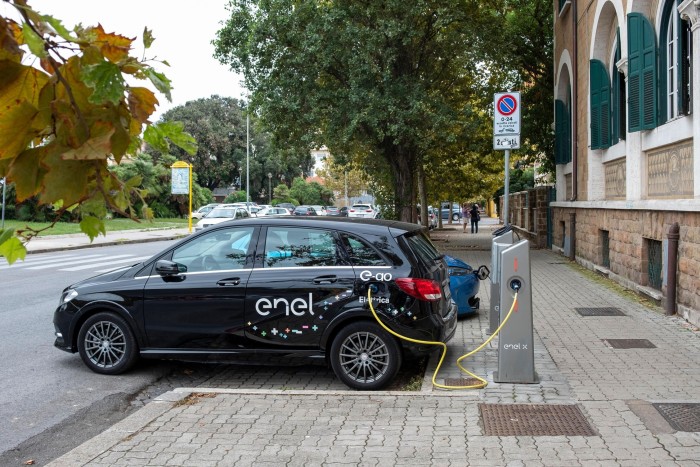Investors urge greater scrutiny of climate funding tools

Roula Khalaf, Editor of the FT, selects her favourite stories in this weekly newsletter.
With governments worldwide pouring billions of dollars into the transition to a low-carbon future, banks are the linchpins for financing wind, solar and other clean energy projects. But their financing tools have drawbacks that can detract from sustainability goals.
Investors have been pumping money into renewable energy funding. In the first six months of 2023, $18bn flowed into environmental and social bond funds globally — nearing the $22bn garnered in all of 2022, according to Bank of America. Almost half of the sustainable bond investments flowed into European funds, BofA said. In the US, sustainable bond inflows reached $1.7bn for the year to date through June 2023, up from $819mn YTD in May.
“Green bond supply has experienced impressive momentum this year,” noted Morgan Stanley in a July report, after the first two quarters of 2023 each set records for issuance: at $176bn and $185bn, respectively.
Countries or companies issue green bonds to pay for specific, low-carbon development projects. They follow voluntary standards developed by the International Capital Markets Association or the Climate Bonds Initiative. There is a lot of leeway in the ‘green bond’ definition, though, which can raise greenwashing concerns.
For example, in the United Arab Emirates, Masdar — the country’s state-owned renewables company — issued a $750mn green bond in July. But Morgan Stanley said this deal was “somewhat controversial” because UAE, as a country, is such a big oil producer.
While green bonds remain banks’ plain-vanilla debt tool for sustainable finance, other products are now catching on. Sustainability-linked bonds (SLBs) tie a company’s debt interest payments to their climate promises by punishing them with higher interest rates if they miss environmental targets. Companies like these bonds because they do not impose any obligations on the business to meet goals such as cutting emissions or water usage, or overhauling their supply chains.
However, analysts suggest the increases in rates embedded in the bonds’ terms have been too small to encourage companies to clean up their act. Similarly, some pension funds and environmental investors have quietly said they do not believe SLBs pay for rigorous climate change projects.

Italian energy company Enel was the first to issue a sustainability-linked bond. It has now issued $29bn-worth, in different deals, since 2019. And Chile has become the second-largest SLB issuer with a total of $8bn. In July, Chile issued the first SLB in Chilean currency. Heathrow airport also issued an SLB for £650mm. Its targets include a goal of reducing Scope 3 emissions.
Banks have a responsibility to show their corporate clients that there is cheap and abundant funding available for commercial climate projects, says Mona Dajani, partner at law firm Shearman & Sterling and its global head of renewables.
“But that comes with the enormous burden of oversight,” she adds. “Banks need to work with their industry peers to not only set standards of their own, but establish what amounts to a covenant for collective enforcement.”
Banks, themselves, have their own net zero goals and are using green bonds to pay for their carbon-cutting projects.
In July, two of the three biggest green bonds were issued by banks. Japanese bank Mizuho issued the largest at $1.4bn and Norway’s DNB issued another at $1.1bn. Of the $23bn of green bonds that companies issued in July, $6.5bn came from the banking sector, according to Morgan Stanley.
“In the last year, especially, we’re seeing momentum tick upwards in green bond issuance by banks,” Dajani says.
But she also notes that “it’s hard to confirm a single number for how many emissions have been eliminated or how much renewable energy has been added to the grid through sustainable-debt financing”.
This is largely a problem of inadequate standards, she explains, pointing out that what constitutes a green bond is ill-defined and the data is messy on the outcomes of products that are funded by green bonds.
“Green bonds aren’t worth anything if their proceeds are committed to a project that would’ve been undertaken anyway, to a project that won’t yield lasting results, or if the results of their financed projects are ambiguously attributable to the project itself,” Dajani says.
Daniel Green, a finance professor at Harvard Business School, agrees that the biggest challenge with green bonds is that “they are primarily used to finance investments that would have been made without access to green bonds”. About a third of green bond issuance globally is used to fund energy projects, he points out, while a majority of proceeds fund transport and building projects.
“While these projects are more sustainable in some way, they almost always increase rather than reduce emissions,” Green says, citing as an example a recent green bond deal to fund expansion at the Hong Kong international airport that would add a runway to ease air traffic congestion.
Now, green investments face a cycle of higher interest rates in many developed and developing countries. In general, higher rates hurt new investments — from homes to infrastructure projects. But green projects might have some immunity, Green believes.
“Some green projects may be insulated because subsidies and regulation make them attractive regardless of funding costs,” he says. “On the other hand, more discretionary green spending may see large cutbacks in a high-rate environment. This pattern has played out for example in the recent slowdown in electric vehicle sales.”
Climate Capital

Where climate change meets business, markets and politics. Explore the FT’s coverage here.
Are you curious about the FT’s environmental sustainability commitments? Find out more about our science-based targets here

Comments